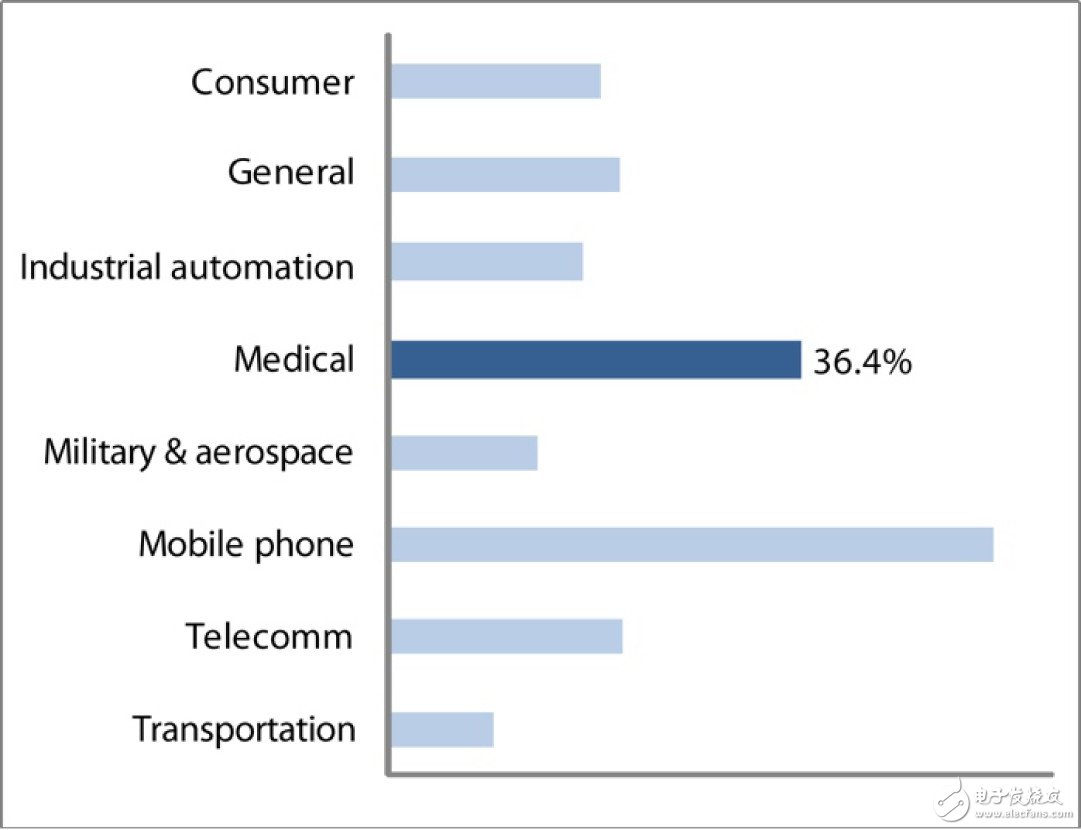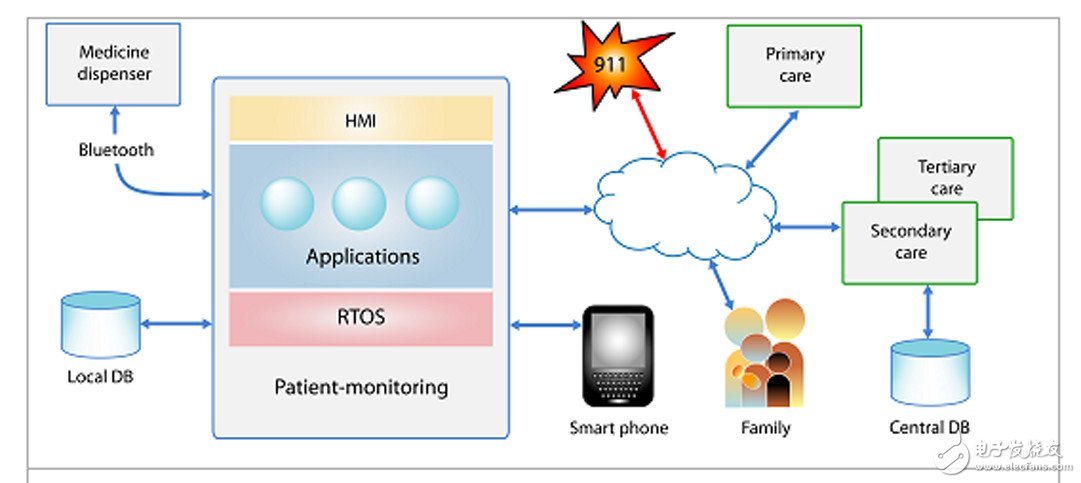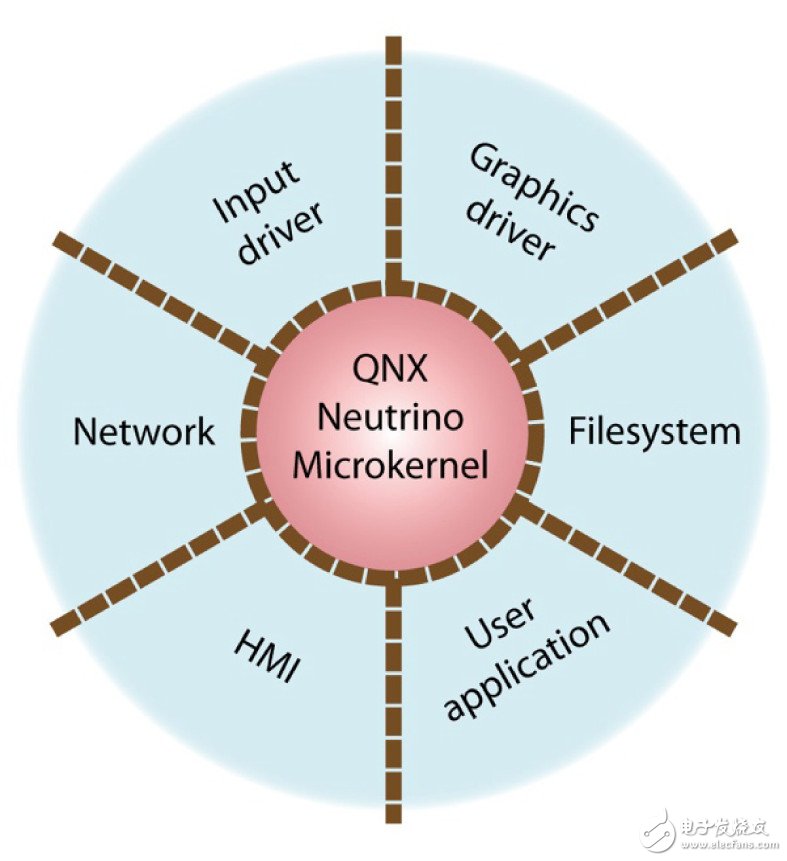The health care services in developed countries have surpassed the hospital-centric model, focusing on primary and secondary medical care, not just hospitals. These initiatives have promoted the development of telemedicine equipment used outside of hospitals, usually used by patients themselves.
The urgent need for telemedicine equipment is driving market growth. The sales of wireless consumer medical equipment in the United States reached US $ 600 million in 2010 and is expected to reach US $ 1.3 billion in 2011. However, compared with the global medical equipment market's annual sales of US $ 200 billion, it is still negligible.
Operating system-key distinguishing elements
The operating system is a key differentiator of all electronic medical devices, and manufacturers understand this very well. In fact, they often choose the operating system before choosing the board.

Figure 1 Proportion of projects that first select the operating system in different industries
The discussion in this article does not include consumer-grade medical equipment, such as its failure to cause serious consequences. For devices that can cause serious consequences in the event of a failure, the key features of the operating system can be classified as follows:
· Credibility: Respond to incidents in a timely and correct manner within a specified time
· Connectivity: communicate with different devices and systems directly or through the network
· Data integrity and security: store data securely and prevent unauthorized access
Each of the above features is worthy of in-depth discussion. Here we only focus on one of the most important features-credibility.

Figure 2 A simple remote patient monitoring network
Choose GPOS or RTOS?
Credibility combines usability and reliability. Usability requires the probability that the system can respond to the request in time, and reliability indicates the correct rate of the response. The requirement for a reliable operating system is to exclude the use of a general operating system (GPOS), because GPOS cannot provide strict guarantees of availability and reliability.
In contrast, the real-time operating system (RTOS) itself is carefully designed to ensure availability and reliability. Designers can rely on the availability of real-time operating systems to respond to demand at any time and the reliability of completing tasks as required. Therefore, it can be concluded that most medical devices require real-time operating systems.
Real-time operating system architecture
Even simple devices like dispensing machines are not allowed to malfunction. If the failure leads to data corruption, the dispensing machine may change the dose, and the ultimate serious consequences can be imagined. Since the operating system architecture has an important impact on the reliability of the system, it should first be strictly evaluated. The three most common architectures of real-time operating systems are real-time execution, macro-kernel and micro-kernel.
Real-time execution architecture
Based on the real-time execution architecture, all software components including the kernel, network protocol stack, file system, drivers, and applications run in the same memory address space. Although this architecture is efficient, it has two obvious disadvantages. First, a single pointer error in any module can damage the memory used by the kernel or any other module. Secondly, no diagnostic information will be left after the system crashes.
Macro core architecture
Some real-time operating systems use macro-kernel architectures (the programs in which can be run as memory-protected processes) to resolve memory errors that may cause the entire system to fail. This architecture does prevent user fault code from damaging the kernel. However, the kernel components still share the same address space with other services. Therefore, a single programming error in any service can cause the entire system to crash.
Microkernel architecture
In the microkernel real-time operating system, device drivers, file systems, network protocol stacks, and application programs all run in independent address spaces outside the kernel, so they are not only isolated from the kernel, but also do not affect each other. The failure of one component will not cause the entire system to be paralyzed, and the memory failure in the component will not affect other processes or cores. In this way, the operating system can automatically restart the failed component.

Figure 3 Microkernel operating system in patient monitoring system
Key features of real-time operating systems
Among the many operating system features, in addition to the system architecture that must be carefully evaluated, other important features include:
· Ensure real-time
· Prevent priority inversion
· Ensure availability
· Monitor and restart process
Ensure real-time
For all systems that need to ensure real-time performance, preemptive cores are critical. For example, an alarm that triggers when a patient falls should be able to preempt the process and issue an alarm.
To ensure that high-priority processes obtain the required CPU cycles at any time, the kernel of the real-time operating system needs to be preemptively run. In addition, the design of the kernel must be as simple as possible to ensure that the longest unpreemptable code path has an upper limit on execution time . As long as the kernel of the operating system can distribute task-intensive operations to external processes or threads, and only include services with short paths, this simple design can be implemented in the kernel of the operating system.
Disposable Vape Puff Flex 2800 puffs is a portable Disposable Vape Pen device with 13 flavors, With 5% nic, 6ml liquid capacity and 850mah battery,Puff Flex will be your first choice Disposable vape.making it the longest-lasting disposables out in the market. Just inhale to fire up the pre-filled device.Double coil will bring the most purest tast and huger vapor on your Puff flex time.Puff flex is a quality and good taste vape with 13 flavors in stock.
Puff Flex Features:
- Disposable pod device requires no maintenance, charging, or refilling
- E-liquid: 10ml Salt Nic E-liquid per Pod Stick
- Available Nicotine: 5% 50mg
- Battery: 1500mAh
- Pre-charged, Simply puff on the device to activate
- Pre-filled, no need for messy refills
- 2800 puffs per pod, approximately equivalent to 80 cigarettes.
- Compact and Portable
Flavors:
1)Watermelon ice
2)Strawberry banana
3)Banana ice
4)Blue Razz lemonade
5)Lush ice
6)Mango ice
7)Pina colada
8)Peach ice
9)Mixed berries
10)Strawberry watermelon
11)Mamba
12)Cool mint
13)Blueberry on ice
disposable Vape pods,QST PUFF 2800, vape wholesale
Shenzhen Essenvape Technology Co., Ltd. , https://www.essenvape.com